Welcome to our guide on how to use ChatGPT to write a book. With the rise of Artificial Intelligence, it has become possible to use AI models like ChatGPT to assist in the writing process. ChatGPT, developed by OpenAI, is a powerful language model that can generate human-like text based on the input it receives.
In this article, we will take you through the steps of preparing a book structure, using ChatGPT to generate title, text and tips and tricks for integrating ChatGPT into your writing process. Whether you’re a fiction writer looking to create compelling characters and plotlines, or a non-fiction writer looking to research and organize your book, ChatGPT can streamline and enhance your writing experience. So, if you’re ready to take your writing to the next level, let’s get started!
First things first, how to structure a book
Writing a book is a complex process, and having a clear structure is essential to ensure that your story is coherent and compelling. There are several different structures that you can use, depending on your genre and the type of story you want to tell. Here are a the most common ones:
The classic three-act structure
- Exposition: Sets the scene and introduces the characters and their conflicts
- Rising Action: Conflicts start to build and the stakes become higher
- Climax: The turning point of the story where the main conflict is resolved
- Falling Action: The aftermath of the climax and the tying up of loose ends
- Resolution: The final outcome of the story
The hero’s journey
- Call to Adventure: The protagonist, the hero, is called to embark on a journey
- Refusal of the Call: The hero initially refuses the call to adventure
- Meeting the Mentor: The hero meets a mentor figure who guides them on their journey
- Crossing the Threshold: The hero embarks on the journey
- Tests, Allies, Enemies: The hero faces various challenges, meets allies, and enemies
- Approach to the Inmost Cave: The hero reaches the climax of their journey
- Ordeal: The hero faces the ultimate challenge and reaches a realization
- Reward: The hero receives a reward for their journey
- The Road Back: The hero returns home and shares their newfound understanding
- Resurrection: The hero reaches a change in their perspective
The Snowflake Method
- Write a one-sentence summary of the story
- Expand the summary into a paragraph
- Create a list of characters and the story’s main conflict
- Write a detailed summary of the story, including the plot, characters, and conflict
- Expand the summary into a chapter-by-chapter outline
- Write the first draft
- Revise and refine
The Seven-Point Story Structure
- Point 1: The Hook: An event that grabs the reader’s attention
- Point 2: The Debate: The main character is presented with a problem and must make a decision
- Point 3: The Break into Two: The main character makes a decision and embarks on a course of action
- Point 4: The B-Story: A subplot that runs parallel to the main story
- Point 5: The Fun and Games: The main character faces challenges and obstacles
- Point 6: The Midpoint: The main character reaches a turning point in their journey
- Point 7: The Bad Guys Close In: The main character faces the final challenge and reaches a resolution
The Monomyth or The Hero’s Journey
- Separation: The hero leaves their ordinary life behind
- Initiation: The hero faces various challenges and obstacles
- Return: The hero returns to their ordinary life, changed
The Three-Act Structure
- Act 1: Setting the scene and introducing the characters and their conflicts
- Act 2: Conflicts start to build and the stakes become higher
- Act 3: The climax, resolution and the final outcome of the story
- Call to Adventure: The protagonist, the hero, is called to embark on a journey
- Refusal of the Call: The hero initially refuses the call to adventure
- Meeting the Mentor: The hero meets a mentor figure who guides them on their journey
- Crossing the Threshold: The hero embarks on the journey
- Tests, Allies, Enemies: The hero faces various challenges, meets allies, and enemies
- Approach to the Inmost Cave: The hero reaches the climax of their journey
- Ordeal: The hero faces the ultimate challenge and reaches a realization
- Reward: The hero receives a reward for their journey
- The Road Back: The hero returns home and shares their newfound understanding
- Resurrection: The hero reaches a change in their perspective
The Snowflake Method
- Write a one-sentence summary of the story
- Expand the summary into a paragraph
- Create a list of characters and the story’s main conflict
- Write a detailed summary of the story, including the plot, characters, and conflict
- Expand the summary into a chapter-by-chapter outline
- Write the first draft
- Revise and refine
The Seven-Point Story Structure
- Point 1: The Hook: An event that grabs the reader’s attention
- Point 2: The Debate: The main character is presented with a problem and must make a decision
- Point 3: The Break into Two: The main character makes a decision and embarks on a course of action
- Point 4: The B-Story: A subplot that runs parallel to the main story
- Point 5: The Fun and Games: The main character faces challenges and obstacles
- Point 6: The Midpoint: The main character reaches a turning point in their journey
- Point 7: The Bad Guys Close In: The main character faces the final challenge and reaches a resolution
The Monomyth or The Hero’s Journey
- Separation: The hero leaves their ordinary life behind
- Initiation: The hero faces various challenges and obstacles
- Return: The hero returns to their ordinary life, changed
The Three-Act Structure
- Act 1: Setting the scene and introducing the characters and their conflicts
- Act 2: Conflicts start to build and the stakes become higher
- Act 3: The climax, resolution and the final outcome of the story
- Point 1: The Hook: An event that grabs the reader’s attention
- Point 2: The Debate: The main character is presented with a problem and must make a decision
- Point 3: The Break into Two: The main character makes a decision and embarks on a course of action
- Point 4: The B-Story: A subplot that runs parallel to the main story
- Point 5: The Fun and Games: The main character faces challenges and obstacles
- Point 6: The Midpoint: The main character reaches a turning point in their journey
- Point 7: The Bad Guys Close In: The main character faces the final challenge and reaches a resolution
The Monomyth or The Hero’s Journey
- Separation: The hero leaves their ordinary life behind
- Initiation: The hero faces various challenges and obstacles
- Return: The hero returns to their ordinary life, changed
The Three-Act Structure
- Act 1: Setting the scene and introducing the characters and their conflicts
- Act 2: Conflicts start to build and the stakes become higher
- Act 3: The climax, resolution and the final outcome of the story
- Act 1: Setting the scene and introducing the characters and their conflicts
- Act 2: Conflicts start to build and the stakes become higher
- Act 3: The climax, resolution and the final outcome of the story
These are some of the most popular structures used in book writing, and you can choose the one that best suits your story. Understanding these structures can help you plan and organize your story in a way that will keep your readers engaged and invested in the characters and their journey. Keep in mind that these structures are not set in stone, you can always adapt and adjust them to fit the unique story you want to tell.
Using ChatGPT to give ideas for a book
By providing ChatGPT with a prompt or a seed text, it can generate text that can serve as inspiration for a story, characters, plot, and even titles. With the ability to generate coherent and diverse text, ChatGPT can help authors overcome writer’s block and come up with new and unique ideas for their books. Additionally, ChatGPT can be fine-tuned for specific tasks such as generating titles, summaries, or even entire chapters. ChatGPT can also assist in the research process by providing ideas and references on a particular topic.
If you have an idea in mind, just go for it. But if you lack of inspiration or want to try something new, you can even ask for ideas for a book:
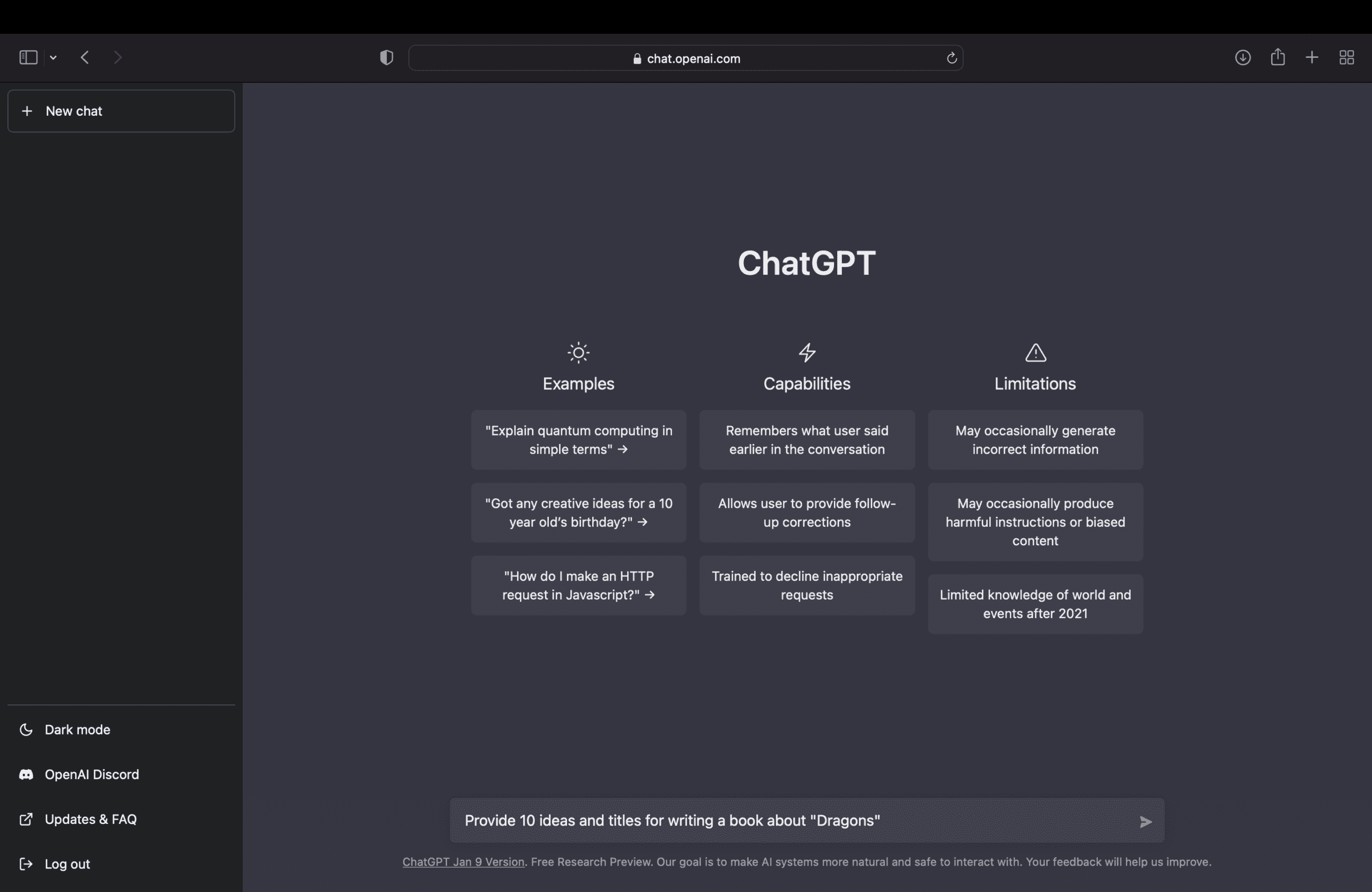
ChatGPT gave us some inspiration. We can tweak this, ask for more option, add or remove some topic until we are fine with the result and can pick one. You also can create your own title directly. For the purpose of this test, we’ve selected one of the titles generated by the AI.
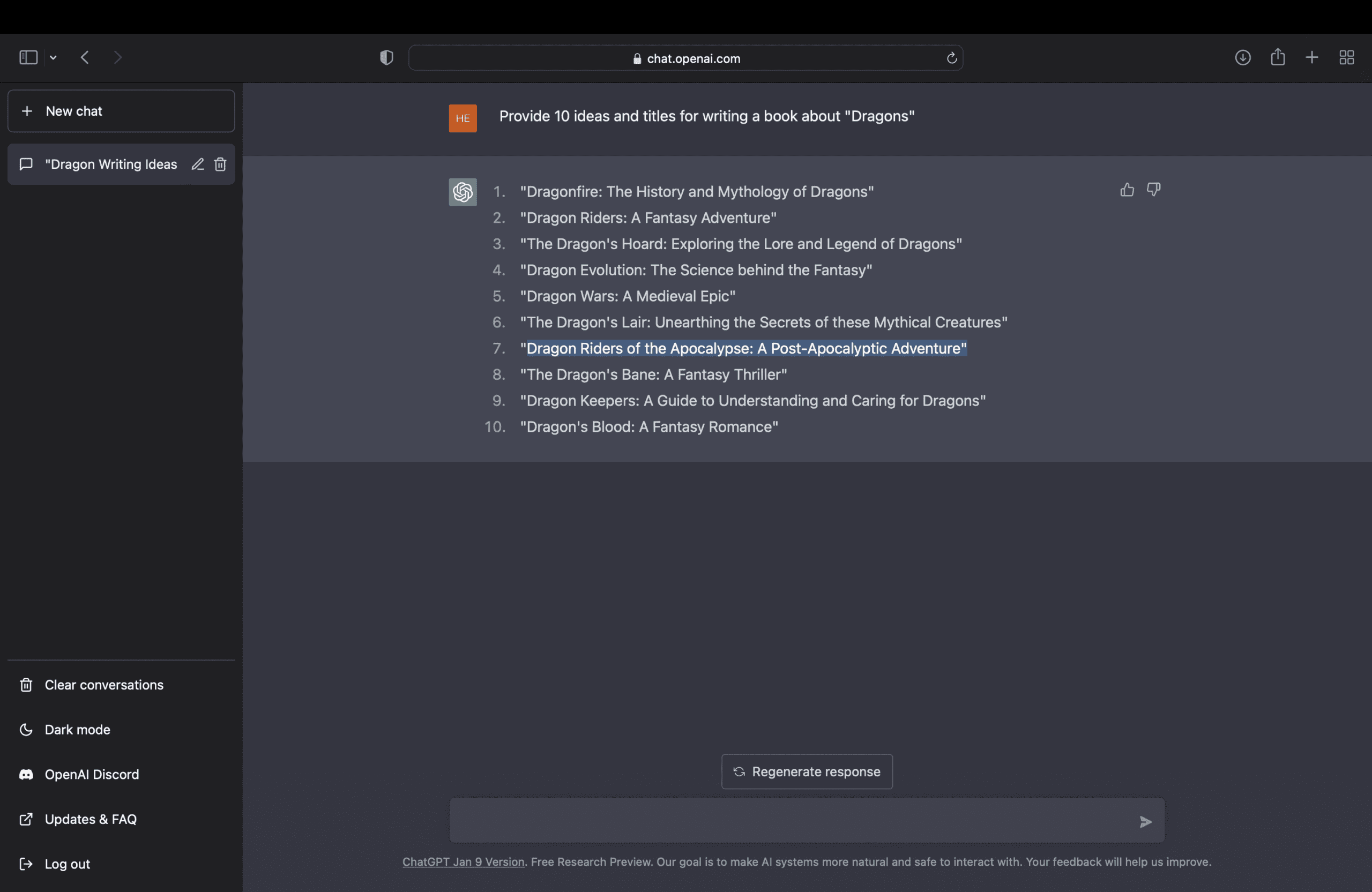
Writing the book using ChatGPT
Structure
After defining the title, we’ve requested ChatGPT to give the outline of a book structure considering a specific structure type: “The classic three-act structure”.
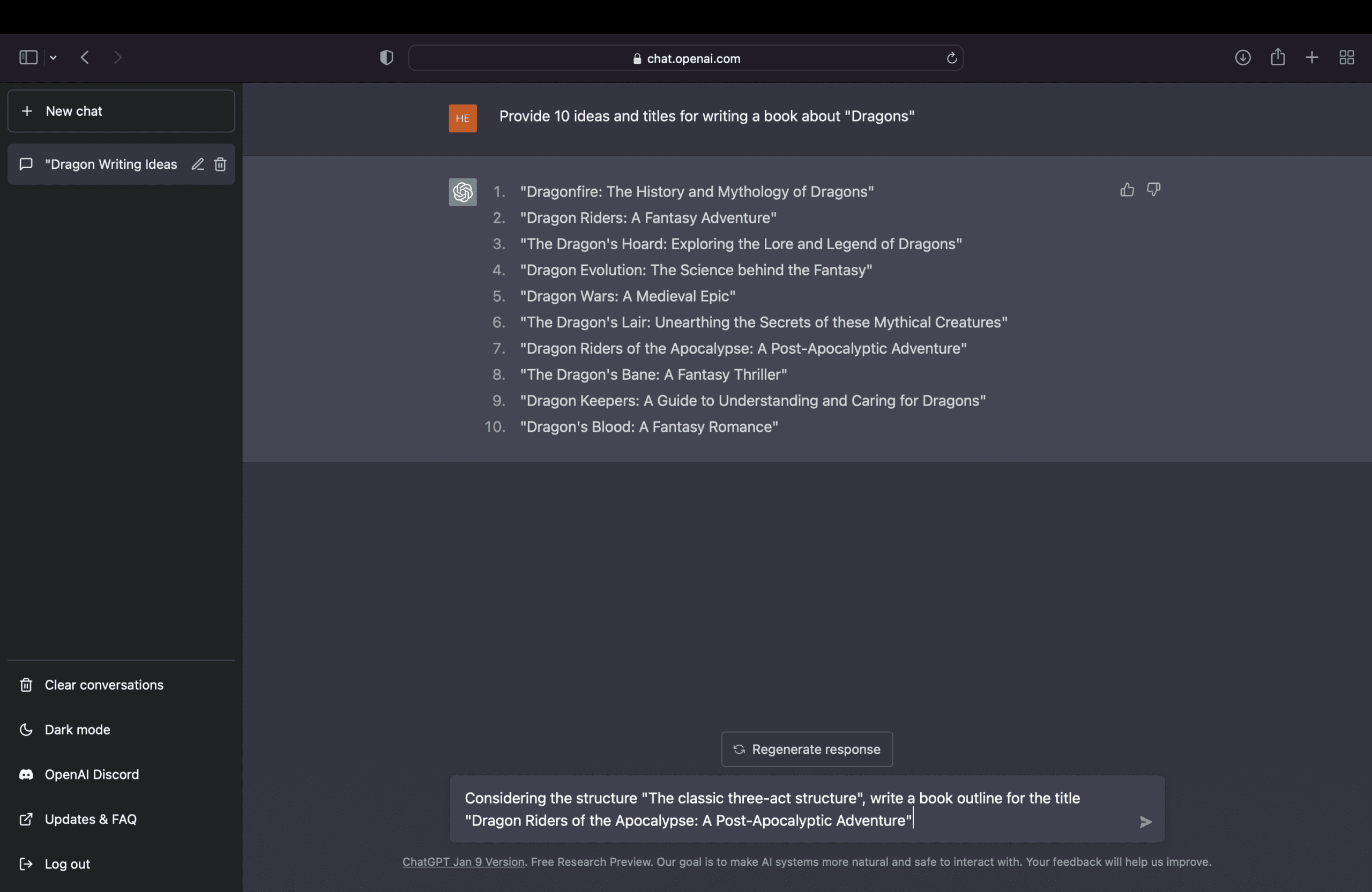
ChatGPT gave an output with the proposed structure. We didn’t tweak anything, but if you like, you can ask to add, remove or change to have your final structure.

Acts and Chapters
Once you’re happy with the structure, you can start detailing the acts and chapters. Here we’ve request to divide into sections. But you can be more specific, ask to divide in a different way and fine tune as you need.
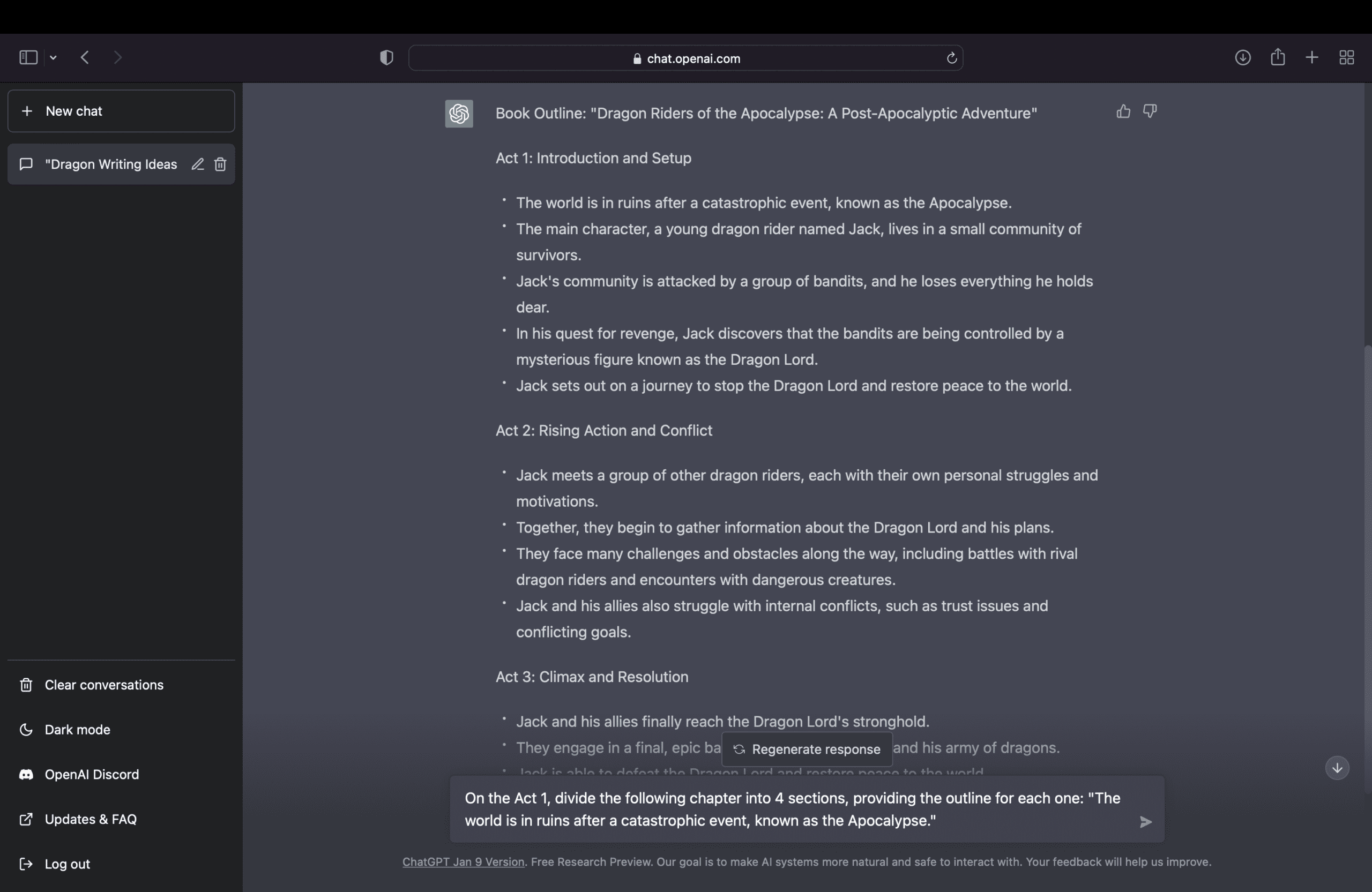
ChatGPT output was the chapter divided into 4 sections, with a brief of each one. Again, here you can tweak what you want, requesting to add, remove or changing things.
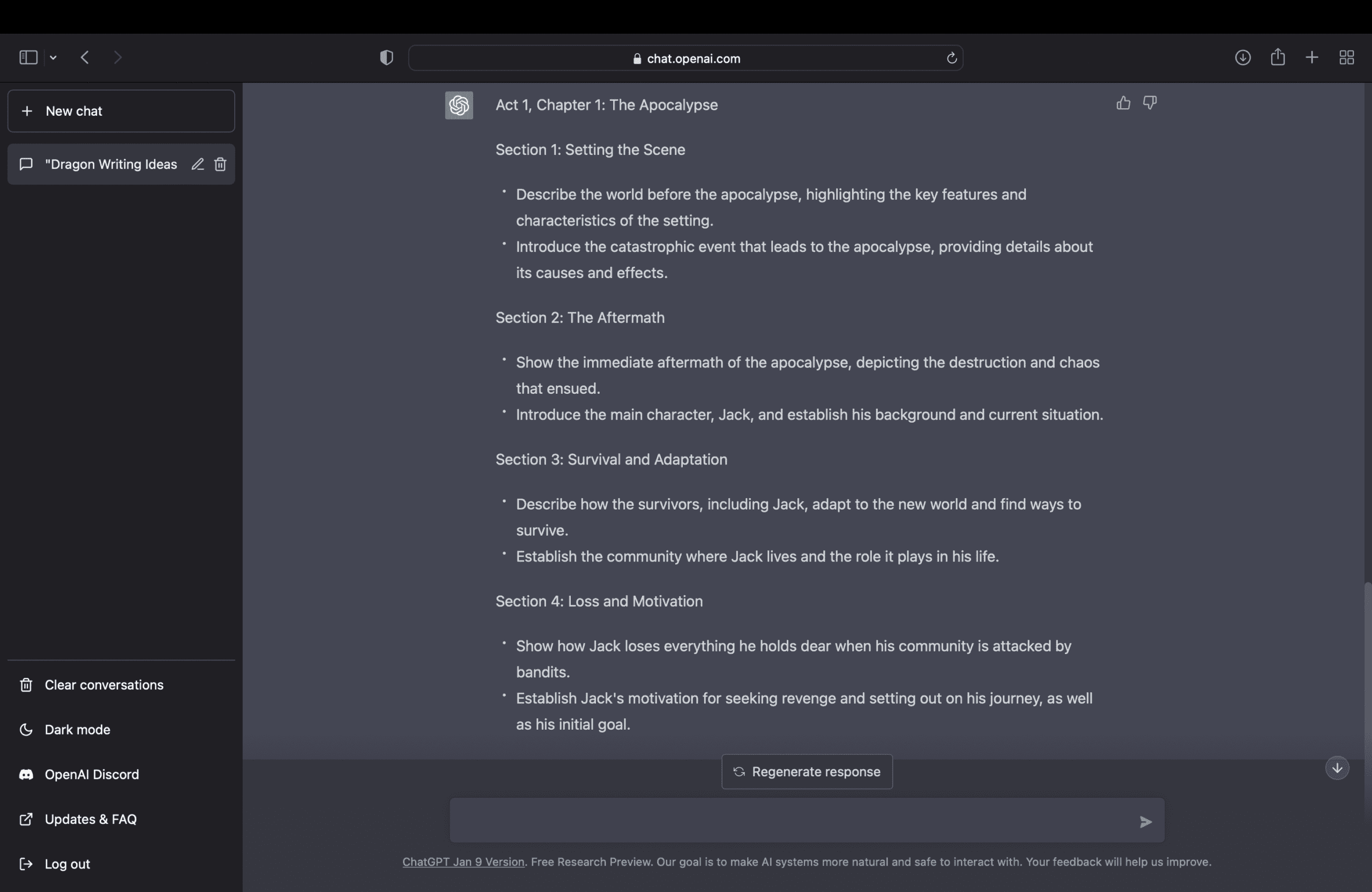
Sections
You could stop here, take the ideas and inputs and with your own creativity write your book accordingly with the structure provided. Now, you’re here to understand how to use ChatGPT to write a book, so, it’s time to finally write the content on each section. We just asked to write, but you can also add elements into the way to write, the size or limit of the content, ask to make references, etc.
Here we just ask to write the text:

And finally we got our content for our book:
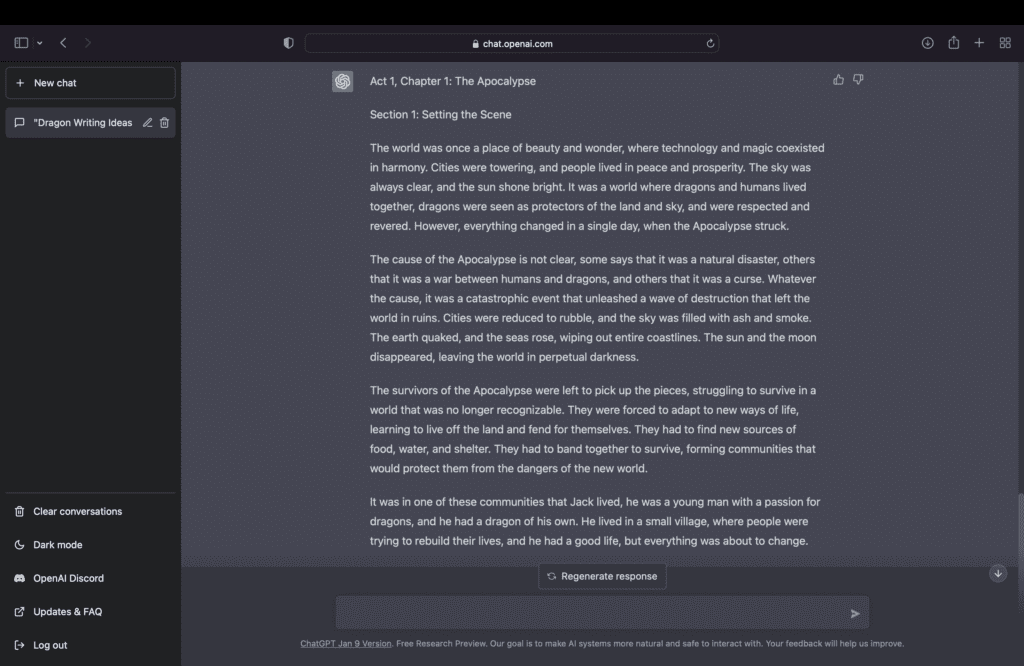
Keep repeating
After doing for one section, keep repeating for each section until you complete the act, then a chapter and finally until you have a complete book. Once again, you can fine tune as many times needed, ask for more details, include or remove chapters, ask to split better the acts and so on. Options for editing are endless.
Conclusion
With the ability to generate large amounts of text, ChatGPT can help authors overcome writer’s block and come up with new and unique ideas for their books.
However, it is important to note that while ChatGPT can generate text that is coherent and human-like, it is not a substitute for human creativity and editing. The text generated by ChatGPT should be treated as a starting point and should be revised and edited by the author to ensure that it meets the standards of a finished book.
In summary, ChatGPT can be a valuable tool for authors looking to generate ideas and overcome creative blocks in their writing process. It can also be used to generate specific content for their books and assist in the research process. With its capabilities, ChatGPT can help authors streamline the writing process and create a finished book that is polished and ready for publication.
If you like, share the content, leave a comment or contact us. Interested in other business areas to make money with AI, take a look on this article.

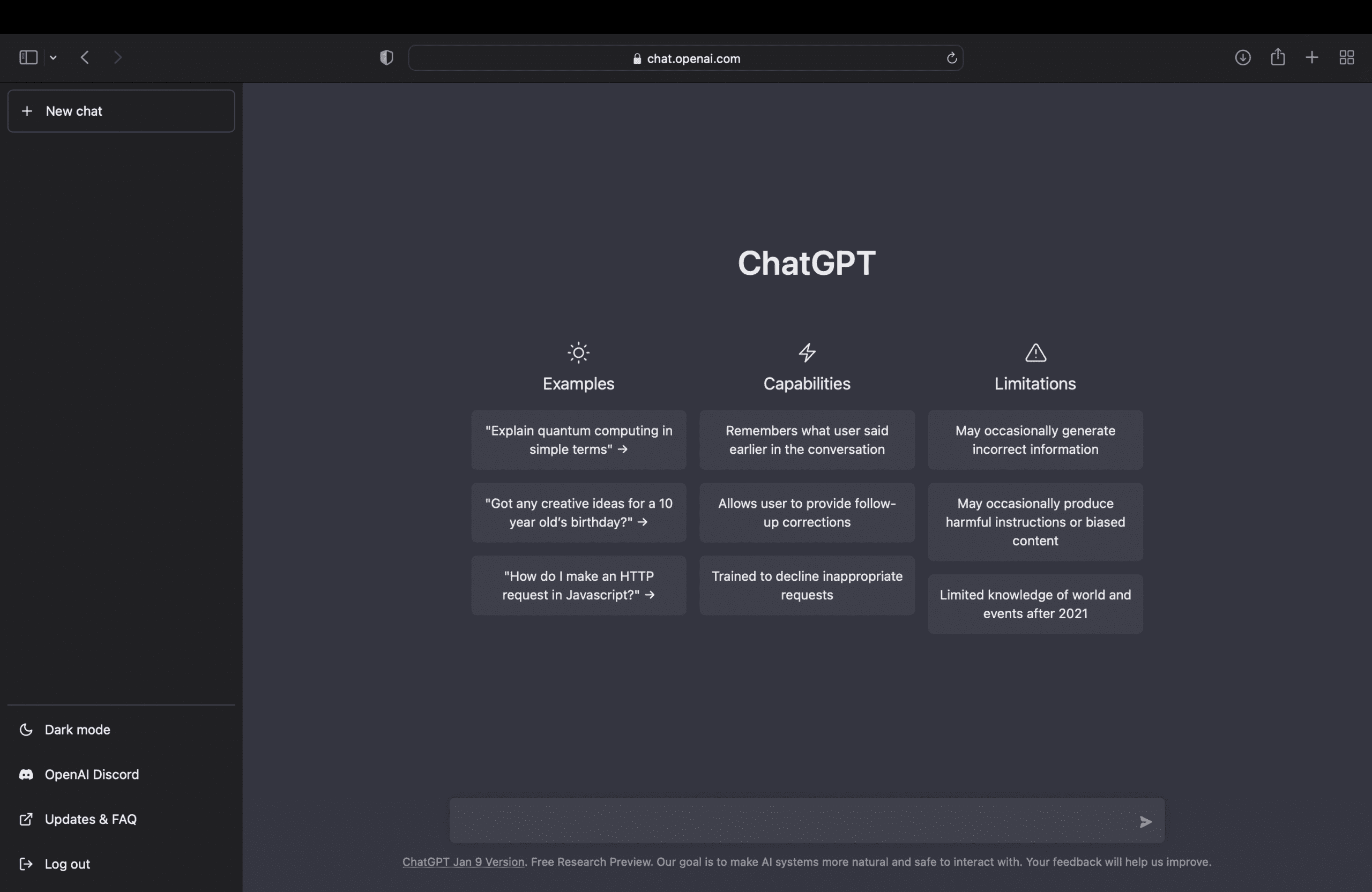
No responses yet